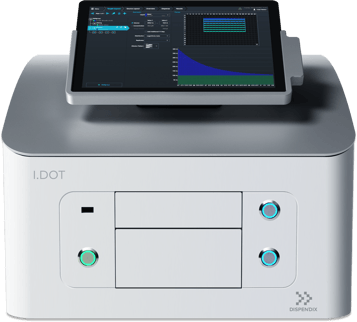Advancements in diagnostics, drug discovery, and ecology have increased the popularity of high-throughput assays for rapidly screening many samples. This shift has brought about the need for practical, cost-effective methods to scale assays while ensuring consistent, reliable results. Assay miniaturization has proven to be a game-changer by helping scientists and clinicians achieve greater assay scalability with smaller sample volumes1. However, miniaturization also introduces challenges with sample preparation, reaction miniaturization, and signal detection. Here, we will explore strategies for miniaturized assay optimization to address these challenges effectively.
Advantages of Miniaturized Assays
There are five key advantages to assay miniaturization.
- Miniaturized assays enable nanoliter scale analysis for reduced sample and reagent volumes.
- Many more samples can be tested simultaneously with miniaturized assays' improved scalability.
- Miniaturized assay optimization enhances signal strength, leading to more sensitive, precise assays2.
- Miniature assays are generally more compact and portable, beneficial for point-of-care and field testing3.
- Reduced volumes mean reduced resources for enhanced cost efficiency, while assay optimization strategies improve time efficiency.
Strategies for Effective Assay Scaling Down
Sample Preparation
Miniaturized assay optimization begins with sample preparation. Tiny volumes must be sufficiently concentrated to avoid compromising results. Precise handling of these small volumes is also tricky, with slight errors impacting assay accuracy. Strategies to optimize sample preparation can help researchers address these issues, including:
- Utilizing microfluidic technologies for precise sample handling and manipulation4.
- Applying miniaturized extraction and purification techniques tailored to small-volume assays, ensuring samples are contaminant-free.
- Using specialized concentration techniques for small sample volumes. These techniques can sufficiently concentrate the sample without significant losses, which is crucial given the limited sample size.
Reaction Miniaturization
Reaction miniaturization is also a key component of effective assay scaling down. Assay optimization strategies for reaction miniaturization include:
- Reducing reaction volumes by scaling down to 384- or 1536-well plates or nanowells allows more samples to be tested while significantly reducing well and sample volumes.
- Automated dispensers like the I.DOT Liquid Handler (Fig. 1) enables accurate, efficient liquid handling of nanoliter and microliter volumes in 96-, 384-, and 1536-well plates5.
- Microfluidic devices control environmental factors such as temperature, pH, chemical gradients, and mechanical forces, allowing researchers to study complex biological environments more easily4.

Figure 1. Automating dispensing with the I.DOT Liquid Handler is a great strategy for miniaturization assay optimization.
Detection Methods
Finally, assay optimization includes selecting the most appropriate detection method(s). Generally, this will be the method that enables the highest precision and sensitivity while being compatible with the miniaturized, high-throughput assay format6. Detection method assay optimization strategies include:
- Applying highly sensitive fluorescence and luminescence-based detection technologies.
- Integrating multiplexing capabilities for the simultaneous analysis of multiple analytes. This further improves throughput capacity by enabling several outputs with a single input and assay7. This is particularly important when working with very limited starting samples, such as patient samples, and is also a great way to bring assay costs down.
- Digital assays involve partitioning a sample into many small, discrete reaction units, reducing background noise and allowing for improved precision and sensitivity8.
Techniques for Overcoming Challenges
Even with the most thorough assay optimization, researchers often face miniaturization challenges, and techniques for overcoming these are essential. First, maintaining an optimal signal-to-noise ratio is crucial and can be achieved by refining detection methods to enhance sensitivity and specificity and employing strategies to minimize non-specific binding. Additionally, results from miniaturized assays need to be easily transferable to larger-scale experiments. Finally, validation and quality control are as essential in miniaturized assays as they are for their larger-scale counterparts. Adapting validation strategies may include developing new calibration protocols, implementing rigorous controls, and ensuring assay reproducibility and reliability.
Conclusion
Miniaturized assays have the potential to revolutionize diagnostics and research by facilitating enhanced scalability, sensitivity, and cost-efficiency. Overcoming challenges in sample preparation, reaction miniaturization, and detection through advanced assay optimization and validation technologies are crucial in enabling their successful application.
Unleash the Hidden Potential of Your Research
Are you looking for effective assay optimization strategies? Book a consultation with one of our experts today to find out how DISPENDIX’s I.DOT Liquid Handler can help accelerate your research, enabling assay miniaturization with more reliable, reproducible results than ever before.
References
-
Pereira SAP, Dyson PJ, Saraiva MLMFS. Miniaturized technologies for high-throughput drug screening enzymatic assays and diagnostics – A review. TrAC Trends Anal Chem. 2020;126:115862. doi:10.1016/j.trac.2020.115862
-
Bosco A, Ambrosetti E, Mavri J, Capaldo P, Casalis L. Miniaturized Aptamer-Based Assays for Protein Detection. Chemosensors. 2016;4(3):18. doi:10.3390/chemosensors4030018
-
Guzman NA, Guzman DE, Blanc T. Advancements in portable instruments based on affinity-capture-migration and affinity-capture-separation for use in clinical testing and life science applications. J Chromatogr A. 2023;1704:464109. doi:10.1016/j.chroma.2023.464109
-
Ortseifen V, Viefhues M, Wobbe L, Grünberger A. Microfluidics for Biotechnology: Bridging Gaps to Foster Microfluidic Applications. Front Bioeng Biotechnol. 2020;8:589074. doi:10.3389/fbioe.2020.589074
-
Silva TC, Eppink M, Ottens M. Automation and miniaturization: enabling tools for fast, high‐throughput process development in integrated continuous biomanufacturing. J Chem Technol Biotechnol. 2022;97(9):2365-2375. doi:10.1002/jctb.6792
-
Kricka LJ, Park JY, Li SF, Fortina P. Miniaturized detection technology in molecular diagnostics. Expert Rev Mol Diagn. 2005;5(4):549-559. doi:10.1586/14737159.5.4.549
-
Ahmad R, Ahsan H. Emerging technology of multiplexing in clinical diagnostics. Int J Health Sci. 2022;16(2):1-2.
-
Basu AS. Digital Assays Part II: Digital Protein and Cell Assays. SLAS Technol. 2017;22(4):387-405. doi:10.1177/2472630317705681